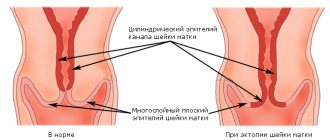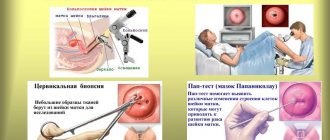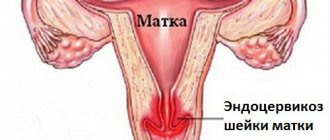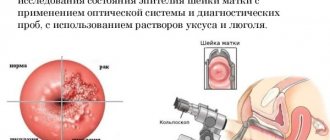Cervical erosion: causes
- hormonal imbalance;
- reduced ability of the immune system to perform its protective function;
- active sexual activity at an early age;
- frequency of changing sexual partners;
- lack of personal hygiene;
- carrying out sexual acts in a rough form;
- trauma due to abortion;
- inaccurate use of intravaginal contraceptives;
- mechanical damage as a result of difficult childbirth;
- infectious diseases and inflammation of the genitourinary system;
- the presence of bacteria in the uterine flora and vaginal dysbiosis;
- hereditary pathologies;
- menstrual cycle disorders.
In a word, cervical erosion occurs from many cause-and-effect processes occurring in the body. The most important thing is not to ignore this disease without the attention of doctors, since in its advanced form there is a predisposition to cancer.
Causes of occurrence in different categories of women
It so happened that many diseases are assigned to certain categories of people. For example, skin problems often occur among those who work with household chemicals and are common among laundresses, and anemia, which is often found in young girls, is called the disease of virgins.
Scientists have not yet been able to find out in which category of women cervical erosion is often found. Previously, cervical erosion occurred in women only after 40 years of age . Nowadays, many young girls are faced with this disease.
Pseudo-erosion is often found in pregnant women, which can go away without medical intervention. But it is necessary to come for examination to a gynecologist after childbirth.
Where does the disease appear in young girls ? Teenagers who have entered into intimate relationships and use various vaginal contraceptives without consulting specialists very often experience erosion.
But it happens that young girls put off visiting a doctor, and in the gynecological chair they are diagnosed with complications that will be much more difficult to get rid of. Doctors can only say that women who have had various infectious diseases most often develop cervical erosion.
Virgins are also not immune to erosion . Where does it come from? Erosion is often congenital or acquired due to hormonal imbalance during puberty.
If erosion is found in a nulliparous woman, then some types of treatment will be difficult, since the procedure leaves scars that can create problems during pregnancy and childbirth. In this case, doctors recommend using the chemofixation method. This method involves eliminating the problem with the help of medications.
https://youtu.be/qwdICcqyh7s
Threats posed by cervical erosion
This pathological condition of the uterine cervix occurs in almost every second woman. But this does not mean that the prevalence of this gynecological disease indicates harmlessness to health and normal functioning of the body. How is it dangerous?
- Cervical erosion serves as a carrier of infectious microorganisms from the vagina to the internal cavity of the uterine fundus: it creates favorable conditions for the development and reproduction of pathogenic bacteria, which can lead to damage to the ovaries, disrupt their functionality and cause further infertility.
- Erosive ulcers and scars can interfere with fertilization and prevent the normal course of pregnancy, and if pregnancy does occur, then with erosion of the cervix, there is a high probability of miscarriage.
- An advanced process and inflamed microflora can provoke the appearance of malignant tumors inside the cervix - as a result, in this case the woman is diagnosed with cancer.
note
Cervical erosion is an insidious disease that in most cases is asymptomatic. Most often, such disorders are detected by chance, during an examination by a gynecologist. But given that cervical erosion can develop against the background of genital tract infections, the following symptoms may be observed:
- The appearance of vaginal discharge, unpleasant odor.
- Discomfort and itching in the genital area.
- Painful sexual intercourse, the appearance of bloody discharge.
- Pain in the perineum and lower back.
If any of these symptoms appear, immediately make an appointment with a gynecologist! You should immediately consult a doctor if you have neoplasms on the genitals that look like cauliflower on a stalk - genital warts.
Symptoms of erosive cervix
Usually erosion is asymptomatic. There are no particularly acute indicators or obvious manifestations of the pathological condition of the uterine cavity. Most often it is detected during routine gynecological examinations. But some signs by which erosive inflammation can be recognized can still be identified:
- increase in the volume of secretions;
- profuse leucorrhoea with an unpleasant odor;
- long menstrual regularities;
- pain when urinating in the lower abdomen;
- convulsive tingling during sexual intercourse.
The symptoms of erosion on a woman’s cervix are very similar to many other diseases of the reproductive system, so they often ignore it or try to heal it on their own, without medical intervention. However, this is a wrong decision, because starting such a disease and bringing it to a severe form is extremely dangerous.
Classification of cervical erosion
According to the level of influence and nature of the consequences, erosive lesions of the cervix are divided into several types.
- Congenital uterine erosion . This type occurs in girls at a young age and practically does not manifest itself in any way. Its diagnosis is revealed during colposcopy - an instrumental procedure for examining the vaginal and uterine space by a gynecologist. Congenital erosion looks like a pronounced scarlet area on the inner surface of the cervix. This type of uterine erosion is considered completely safe and does not require medical intervention or elimination, because it does not cause pain or pose a threat to the process of childbirth. In most cases, it is eliminated on its own during pregnancy due to changes in the increased hormonal activity of the female body.
- True uterine erosion . This type of erosion differs from congenital erosion and is not safe. The source of its occurrence is located in the pharynx of the uterus (the place where the canal passes directly into the uterine cavity). Although it is considered a benign deviation of the vaginal mucosa, it affects the tissue of the inside of the cervix, causing the formation of purulent abscesses. As a result, a woman may suffer from unpleasant purulent discharge with a pungent odor, lasting for 1.5–2 weeks. Such erosion is common to the majority and is a common pathology, but in the absence of proper medical attention it can develop into pseudo-erosion.
- Ectopia of the cervix (pseudo-erosion) . Most often occurs in women under 40 years of age. It can be congenital, acquired, complicated, papillary, glandular or mixed. Such ectopia is expressed by an increase in the cylindrical epithelium of the uterus and its extension beyond the cervix into the vagina, which provokes a hormonal imbalance and causes subsequent irritation. The whole process is accompanied by itching of the surface of the female genital organ, menstrual cycle disorder, and the discharge of strange blood and mucous masses from the vagina. A complex form of pseudo-erosion prevents a woman from becoming pregnant, and in the case of a recurrent stage leads to cancer.
In addition to the listed main types of erosion, several more varieties can be distinguished depending on the nature of the manifestation:
- endometriosis – expressed in an increase in cervical tissue beyond the mucous membrane of the uterine fundus;
- ectropion - manifests itself in the inversion of the mucous membrane of the cervical canal into the vaginal cavity (occurs as a consequence of abortion or postpartum pathology);
- leukoplakia - is a compaction and further coarsening of the epithelium, which leads to thickening of the cervix and the appearance of white spots on it (an absolute deviation from the normal functioning of the uterine epithelium);
- polyp is a wart-like phenomenon on the surface of the cervix, causing pain during sexual intercourse and subject to mandatory removal: you need to get rid of it as soon as possible by contacting specialists immediately after identifying the symptoms;
- condylomas are carriers of viral microorganisms that enter the mucous membrane of the cervix and signal the danger of cancer.
Diagnosis of erosive lesions of the cervix
Confirmation of concerns regarding the presence of erosion in the cervix, if any, can only be obtained from a qualified doctor. Self-diagnosis is contraindicated in this case. Even an initial examination by a gynecologist does not always fully enable the doctor to diagnose a specific type of erosion. To do this, he sends the patient for examinations and the following medical procedures:
- taking a smear of vaginal flora;
- polymerase chain reaction for infection;
- colposcopy;
- urine culture tank;
- biopsy;
- general blood test and reaction to sexually transmitted diseases.
The earlier erosion is diagnosed, the more effective its treatment will be. Moreover, if it is installed early, it will be possible to avoid such a radical method of elimination as cauterization.
Possible consequences
An open wound on the mucous membrane is a gateway for the penetration of pathogenic flora. That is, this means that pathogens can affect not only the vaginal and cervical area, but also penetrate the uterus, causing serious pathologies caused by the inflammatory process.
Bleeding erosions can cause anemia. In some cases, bleeding can be so heavy that it can only be stopped by taking hemostatic medications.
Erosion in some cases can cause infertility. Adhesions that form on the mucous membrane of the cervix can prevent the normal passage of seminal fluid through the canal.
IMPORTANT!
The most dangerous consequence is the transformation of erosion into a malignant process.
What else is dangerous about cervical erosion, read here.
Erosion treatment method
Depending on the type of erosive lesion of the cervix, doctors use conservative or surgical treatment methods.
The conservative technique involves lightweight therapy by prescribing medication to the patient in accordance with her general condition and the level of development of uterine erosion. This therapy is suitable in cases of congenital or true erosion and assumes that the patient will use and take on an outpatient basis:
- antibiotic drugs;
- antifungal medicine;
- antiviral medications;
- antiseptics;
- anti-inflammatory ointment (for external use);
- healing and restorative drugs.
A surgical technique is required when diagnosing pseudoerosion, leukoplakia or erythroplakia of the cervical mucosa. Such a radical method of treatment is carried out if conservative therapy has not yielded results or the degree of advanced erosion is so great that conventional therapy cannot be done. It is cauterized using various surgical methods:
- ultrasound;
- chemical cauterization;
- radio wave coagulation;
- nitrogen freezing (cryodestruction);
- current cauterization (diathermocoagulation).










